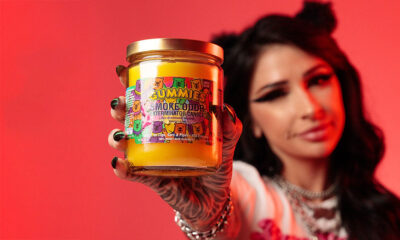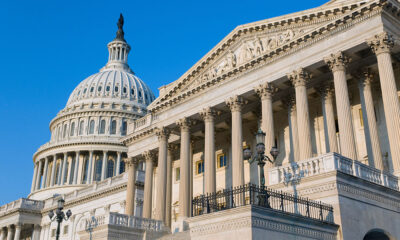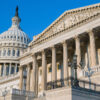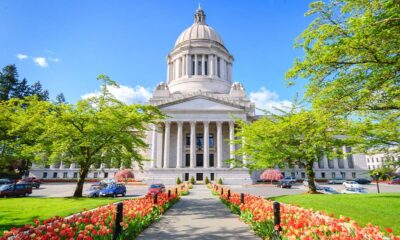
Politics
Are States Redlining Cannabis Dispensaries?
Recent research suggests lower-income areas in America have more than their fair share of marijuana dispensaries—a phenomenon seen in states nationwide.
“Urban decay” in America speaks a universal language, a vernacular seen and heard in movies, political ads and in real life. It sounds like this: Broken windows, vacant buildings, graffiti-covered walls and doors. Ne’er do-wells loitering outside liquor stores and pornography merchants (less visible in the online era but still a part of this classic trope). But thanks to cannabis legalization, struggling areas in America have another feature: legal cannabis dispensaries. The higher concentration of dispensaries in America’s lower income areas may be due to the destructive practice of “redlining.”
According to recent research out of Washington state and published in the journal Drug and Alcohol Dependence, along with other elements “polite society” may deem unsavory, cannabis dispensaries also tend to coalesce in lower-income areas, which in turn—since race so often correlates with class—also tend to be less white.
The wealthier, whiter areas, by contrast, tend to limit or ban cannabis businesses outright. This in turn fuels a vicious cycle: Because cannabis dispensaries are lumped in with the pawn shops and liquor stores of Skid Row, cannabis dispensaries acquire an unsavory reputation—and then they’re shunted towards seedier parts of town in cities that newly legalize.
This all adds up to a sort of post-legalization redlining—a phenomenon several scholars as well as activists are noticing.
Though this new research was conducted in Washington, previous studies also found that adult-use cannabis stores “are more likely to concentrate in economically disadvantaged areas.” Similar situations are seen across the country. When a city council or county planning department determines the local “green zone”—the area of the city declared open for cannabis businesses—that area tends to be an industrial or low-income area.
“Most cannabis green zones are in low-income areas, and it’s been causing problems for both the residents and cannabis businesses,” said Amber E. Senter, an Oakland, California-based cannabis entrepreneur and social-equity activist who co-founded Supernova Women, which advocates for BIPOC participation in the legal cannabis industry (and was not involved with the study).
Keep in mind how cannabis legalization was pitched to policymakers and the public after decades of cannabis-centered drug war overpolicing and incarceration. The fact that these cannabis businesses are more often than not owned by white investors and entrepreneurs who are extracting revenue that once went to “traditional market” sellers from Black and Brown communities only further highlights what’s yet another shortcoming in marijuana legalization’s social-justice mission.
In the study, researchers from the University of Washington and the Oregon Public Health Division surveyed 10,009 people aged 18 to 25 living in Washington state. Surveys were collected from 2015 to 2019. Respondents were asked to report their cannabis use, whether cannabis was easy to access, and whether cannabis was deemed “acceptable” in their community.
Respondents’ “neighborhood disadvantage,” a metric derived from “five US census variables,” was also assessed. And “neighborhood disadvantage” tended to indicate weekly or daily cannabis use as well as “greater perceived acceptability of cannabis use.” People who lived within one kilometer “of at least one cannabis retail outlet lived in census tracts with greater neighborhood disadvantage,” the researchers found.
Study authors noted it wasn’t immediately clear if people in low-income areas smoked cannabis because that’s where the cannabis was, or if coping with the stresses of living a disadvantaged, over-policed area meant more cannabis use.
Authors did not respond to emails seeking comment on the redlining of cannabis dispensaries. However, “If similar findings continue to emerge,” they wrote in their study, “this may suggest that states should seek to limit the geographic availability of retail outlets in order to prevent population-wide increases in cannabis use and related harms.”
Cannabis Redlining Explained
What does de-facto cannabis redlining look like in action? New York State offers an example. The state legalized adult-use cannabis last year, but communities had until Dec. 31, 2021, to decide whether to ban dispensaries and consumption lounges. (In a departure from other states, cities and towns could not ban cultivation.) And according to the Rockefeller Institute of Government, about half of the state did pass bans.
Where was cannabis banned? In Westchester County, a wealthy suburb immediately north of New York City and the second-wealthiest county in the state after Manhattan, most cities chose to ban. In St. Lawrence County, the second poorest (ahead of the Bronx), most cities, towns and villages have opted in.
New York is only the most recent example. In New Jersey, about 70 percent of the state “completely opted out of the recreational cannabis industry,” the New Jersey Herald reported last summer. Those 98 municipalities that did allow dispensaries—“mostly in South Jersey and Central Jersey,” according to the paper, with working-class and industrial areas in Newark allowed, but not the tonier suburbs of New York City—limited them to “one particular redevelopment area or zone.”
In New Jersey, at least some areas opted out because they felt the process was moving too quickly, or that they didn’t get enough guidance from the state. But some others associated cannabis with “quality-of-life” issues, like the fear of the Skid Rows described above.
As Michael Soriano, the mayor of Parsippany-Troy Hills said, redlining (or marijuana zoning), his community “fits what our residents would allow and what our infrastructure had to offer.” And as a cannabis business consultant told the paper, the towns that opted in had lower median incomes and were eager to supplant their budgets with cannabis tax revenue.
There is nothing inherently seedy about a weed store, in the same way there is nothing inherently seedy about a store that sells liquor. Think of a high-end wine shop. Now think of a neon-lit storefront offering plastic bottles of cheap vodka from behind bullet-proof glass. They’re both in the same line of work; they both have a license from the same state regulator.
The same is true with cannabis. Yet Americans and American policymakers think differently. Until they do, cannabis stores are victims of a policy that, regardless of intent, falls into the same patterns of behavior of cannabis prohibition.

























